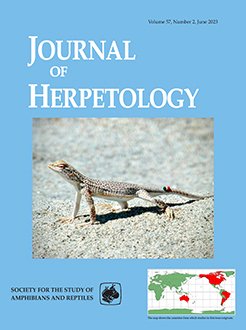Boris Marioni, José António L. Barao-Nobrega, Sergio Santorelli JR., Richard Carl Vogt, William Ernest Magnusson, Francisco Villamarín
Journal of Herpetology 57 (4), 400-407, (18 December 2023) https://doi.org/10.1670/22-014
Syntopic species share the same habitat in time and space. Thus, although some species might have completely coincident spatial distributions on a relatively broad scale, most are syntopic only in certain locations. Four species of caimans (Crocodylia: Alligatoridae) occur throughout the Amazon basin, but they are rarely found living in syntopy. In locations where all four caiman species coexist, their distributions and occurrences have not been studied simultaneously to determine to what degree they partition space. We carried out extensive spotlight night-surveys from 2013 to 2017 to better understand how the four caiman species coexist in sympatry and quantify the degree to which they differ in habitat use and space occupancy. The strictly Amazonian species of caimans —Melanosuchus niger and Paleosuchus trigonatus—were less likely to occur close to each other than other species pairs, suggesting that these species occupy different sections within waterbodies in the same microbasin. Caiman crocodilus had the highest encounter rates and was mainly associated with varzea floodplains and exhibited a high degree of spatial overlap with Melanosuchus niger. Paleosuchus trigonatus was the only species showing encounter rates increasing with the proportion of nonflooded forest around waterbodies but that relationship was not statistically significant. Based on spatial distributions, Paleosuchus palpebrosus seem to be the species that most often shares space with other Amazonian caiman species, because it was the only regularly syntopic species. The fact that each species represented its own most frequent neighbor indicates a clustered distribution of caimans, likely a result of habitat segregation among species. Although the phylogenetically related species tended to occupy the same ecosystem, habitat partitioning may enable the coexistence of four crocodilian predators in one catchment.
Espécies são consideradas sintópicas quando ocorrem no mesmo habitat. Porém, embora algumas espécies possam ter distribuições espaciais completamente coincidentes, a maioria é sintópica apenas em alguns locais. Quatro espécies de jacarés (Crocodylia: Alligatoridae) ocorrem em toda a bacia amazônica, mas raramente são encontradas etermi em sintopia. Em locais onde as quatro espécies de jacarés coexistem, sua distribuição e ocorrência não foram estudadas simultaneamente para eterminer o grau em que elas dividem o espaço. Através de extensas coletas noturnas de 2013 a 2017, nosso objetivo foi entender como as quatro espécies de jacarés coexistem em simpatria e quantificar o grau em que diferem no uso do habitat e na ocupação do espaço. Nossos resultados demonstraram que as espécies de jacarés amazônicos, Melanosuchus niger e Paleosuchus trigonatus, foram as que possuíram a menor tendência de ocorrerem próximas uma da outra, quando comparado com as outras espécies; sugerindo que essas espécies ocupam diferentes seções dos corpos d¨água na mesma microbacia. Caiman crocodilos foi a espécie com as maiores taxas de encontro, esteve principalmente associado as planície de várzea e mostrou um alto nível de sobreposição espacial com Melanosuchus niger. Considerando as distribuições espaciais das quatro espécies, foi identifi cado que i) Paleosuchus palpebrosus é a que mais compartilha o espaço com as outras espécies amazônicas, por ser a única espécie regularmente sintópica, além ii) da existência de agrupamento na distribuição dos jacarés, como provável resultado da segregação de habitat entre as espécies. Por fim, espécies filogeneticamente relacionadas tenderam a ocupar os mesmos habitats, mas a partição desse habitat permite que as quatro espécies de jacarés possam coexistir em uma mesma microbacia.

